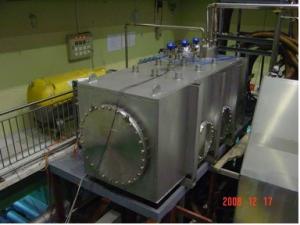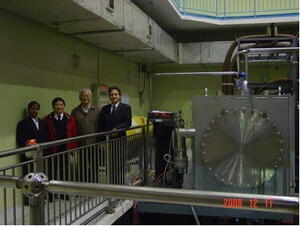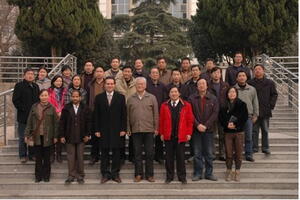China successfully tests HTS current lead
A prototype of the 68 kA high temperature superconductor (HTS) current lead for the ITER toroidal field coil has been successfully tested in the Institute of Plasma Physics of the Chinese Academy of Sciences (ASIPP) in Hefei, China. On 17 and 18 December, the HTS current lead was operated at 85 kA for several minutes and 90 kA for five minutes. The 90 kA level is more than 32 percent above the nominal operating current.
HTS current leads are designed to transmit high power currents from the room temperature power supplies to the low temperature superconducting coils with minimum heat load. For this they use a short segment of high temperature superconductor which can carry much higher current densities than a normal conductor such as copper. It can thereby conduct the current in much less material (smaller cross-section), thus reducing heat conduction. The heat load reduction by the HTS current lead results in a decrease of the power input, and thus will greatly improve the efficiency of the ITER device and dramatically reduce the operation cost. The HTS current lead technology is therefore one of the "enabling" technologies for a fusion tokamak.
The Institute of Plasma Physics of the Chinese Academy of Sciences (ASIPP) in Hefei, China, started the development of such current leads more than one year ago. The HTS current leads are part of the so-called feeders, a set of ITER components provided entirely by China.
In another test the 68 kA HTS current lead was operated in steady state for 42 minutes. The test confirmed the simulated low temperature end conduction heat-load of less than 10 W per lead. It also revealed a current lead to the busbar joint resistance of less than 1nOhm, which is lower than expected. The busbar is a superconducting cable operating at low temperature, which transmits the current further to the toroidal field coils. All of these results are preliminary and more test results will be delivered in the near future. 90 kA operation establishes a new world record for the operating current of a HTS current lead. With this successful test ASIPP, China and the world just made a big step toward ITER.




